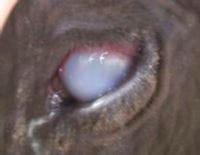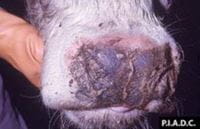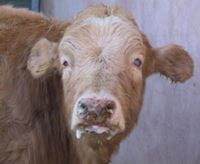Malignant Catarrhal Fever (MCF) is a viral disease mainly of ruminant animals such as
- cattle,
- bison,
- deer; and
- moose.
It is usually fatal in highly susceptible species such as bison. Unlike bison, cattle are very resistant to the MCF virus. However, occasional cases in cattle do occur and, when they do, the outcome is usually fatal.
Causes
MCF is caused primarily by two different herpes viruses, one type which is found in wildebeest and a different type which is found in sheep. Although these animals can be carriers of the virus, they do not suffer from any ill effects. The wildebeest virus is rare in North America, since animals here exist only in zoos or exotic animal collections. The sheep-associated virus is very common in North America to such a degree that it is assumed that most sheep are carriers.
The virus ovine (sheep) herpesvirus-2 (OvHV-2)m is shed in the nasal secretions of carrier sheep. It can be spread to bison through direct contact with carrier sheep; however, the virus also becomes aerosolized (airborne). Several studies have shown that bison with MCF do not pass the virus on to other bison.
MCF in Bison
Symptoms
Bison may be found dead without symptoms, become ill and die in seven to 10 days, or develop a chronic form in which they are ill for months before they die. Symptoms in bison sometimes are very subtle and may be missed or misdiagnosed, as bovine viral diarrhea virus (BVDV), respiratory virus, or a bacterial infection.
The following are some of the most common symptoms:
- Depression – head down, animal separates from herd, reduced or loss of appetite.
- Cloudy/ulcerated eye – slightly gray to totally white, may be in one or both eyes. In more extreme cases, the eye could bulge or even rupture.
- Weeping eye – tearing from a slight bit to two to four inches of wet hair under the eye.
- Snotty nose – watery discharge to white (milky) mucous strands from one or both nostrils (more severe in cattle than in bison).
- Salivating – clear watery mucus dripping from the mouth.
- Erosions/ulcers – small sores or open lesions in the mouth which can extend into the throat and esophagus.
- Fever – up to 42.5 C, but the temperatures can vary over a wide range.
- Swollen joints – may be seen 10 to 12 days prior to onset of any other symptoms.
- Difficult urination – frequent, painful urination or bloody urine.
- Other symptoms – coughing, aborted fetus, dehydration, diarrhea, tremors or circling.
Treatment
There is no effective treatment available for MCF in bison. Bison that become clinically ill will invariably die.
Time of year and environment
MCF can occur any time throughout the year. It appears to be more prevalent during the winter months, which is when lambs come of age (between six to nine months). This group of sheep may shed more virus. It is also possible that the virus survives better in the cold winter season. Carrier sheep shed more virus and bison are more susceptible during times of transportation, handling, birth and weaning.
The virus can survive up to 72 hours in the environment, but may survive up to 13 days if the environment is moist.
Prevention
Vaccine
There is no vaccine to prevent MCF in bison, nor is there a vaccine for the virus in sheep.
In general, increasing the distance between sheep and bison reduces the risk. Information has changed in recent years as to the distance that should be kept between these animals. However, there is still no definitive science on what is considered a minimum safe distance This is because the risk of MCF varies depending on many factors besides distance, such as the age of the sheep; the size of the flock; climate; wind; and temperature.
Bison producers are discouraged from establishing herds or pastures near sheep producers, and sheep producers are likewise discouraged from establishing flocks or pastures near bison. Producers are urged to consider their proximity to other species, and to minimize opportunities for contact with the other species and their secretions particularly during times of transportation, handling, birth and weaning.
Prevalence of OvHV-2 in the Canadian sheep flock
The prevalence of OvHV-2 in the Canadian sheep population is unknown. Studies conducted in the USA suggest that OvHV-2 may be very prevalent in North America.
An animal has MCF or has died of MCF?
If you suspect your animal has MCF, contact your local veterinarian. Tests can be done on live or dead animals to determine if they are infected with the virus. If the animal has been found dead without prior symptoms, it is important that other causes of sudden death, such as anthrax, are ruled out.
If MCF is found in your herd, your veterinarian can advise you on appropriate biosecurity measures you can take to minimize the potential for future incidents.
MCF in cattle
Cattle become infected with the virus through direct contact with carrier sheep or their secretions (i.e. contaminated feed bunks or water bowls). While the airborne virus can infect the highly susceptible bison, there is less of a risk for infection in cattle. Cattle are dead-end hosts; that is, cattle with MCF do not spread the virus to other animals.
MCF virus attacks the blood vessels in multiple organs so clinical signs can be quite variable and may include sudden death, high fever, diarrhea (sometimes bloody), ocular (eye) and nasal discharge, or seizures. Death can occur quickly, sometimes preceded by a short period of depression, diarrhea and loss of appetite, but often with no other apparent symptoms. More apparent clinical signs are seen when animals survive longer. Animals with acute disease develop a high fever and stop eating. Cattle often have bilateral corneal opacity that begins at the outer edge of the eye and progresses inward.

Fakri Fatima Zohra, WikiMedia

Credit: Plum Island Animal Disease Center
Watery discharge from the nose and eyes is common early in the course of the disease; later, this discharge becomes thick and cloudy. The muzzle and nostrils are usually encrusted, and laboured breathing and salivation may be seen. The inside of the mouth is often reddened and with erosions and ulcers. The skin is sometimes reddened or ulcerated, and hardened scabs may develop. In some animals, the hoof may be loosened or slough off. The joints may be swollen, milk production often drops, and the superficial lymph nodes are markedly enlarged. Diarrhea, with or without blood and blood in the urine can also be seen. Occasionally, animals have nervous signs including increased sensitivity to touch, incoordination, disorientation, tremors, rolling of the eyes or head pressing.

Photo Credit: National Animal Disease
Information Service, UK
Although many animals die of chronic infection (lasting weeks or months), recovery is possible. There is no vaccine and there is no treatment for this disease.
MCF can occur any time throughout the year. It appears to be more prevalent during the winter months, which is when lambs come of age (between six and nine months). This group of sheep sheds more virus. It is also possible that the virus survives better in the cold winter season. Cattle are more susceptible during times of stress, such as transportation, handling, birth and weaning.
In Saskatchewan, MCF in cattle tends to occur infrequently. Only a few cases are confirmed by laboratory testing each year. Without laboratory testing, cases may be misdiagnosed as other, more common cattle diseases such as Bovine Viral Diarrhea (BVD) or Infectious Bovine Rhinotracheitis (IBR). Therefore, confirming a diagnosis of MCF requires laboratory testing.
In most cases, cattle and sheep can be raised together without any problems provided a few basic guidelines are followed:
- Keep young lambs (weaning up to 10-11 months of age) away from cattle;
- Do not mix sheep and cattle during times of stress;
- Do not house sheep and cattle together indoors; and
- Do not pen sheep and cattle together in crowded conditions.
MCF Task Force report
The Saskatchewan Minister of Agriculture created this Task Force in response to concerns voiced by industry members in Saskatchewan over the potential risk of MCF occurring in bison as a result of exposure to sheep. View the Final Report to the Saskatchewan Minister of Agriculture - December 2011.
